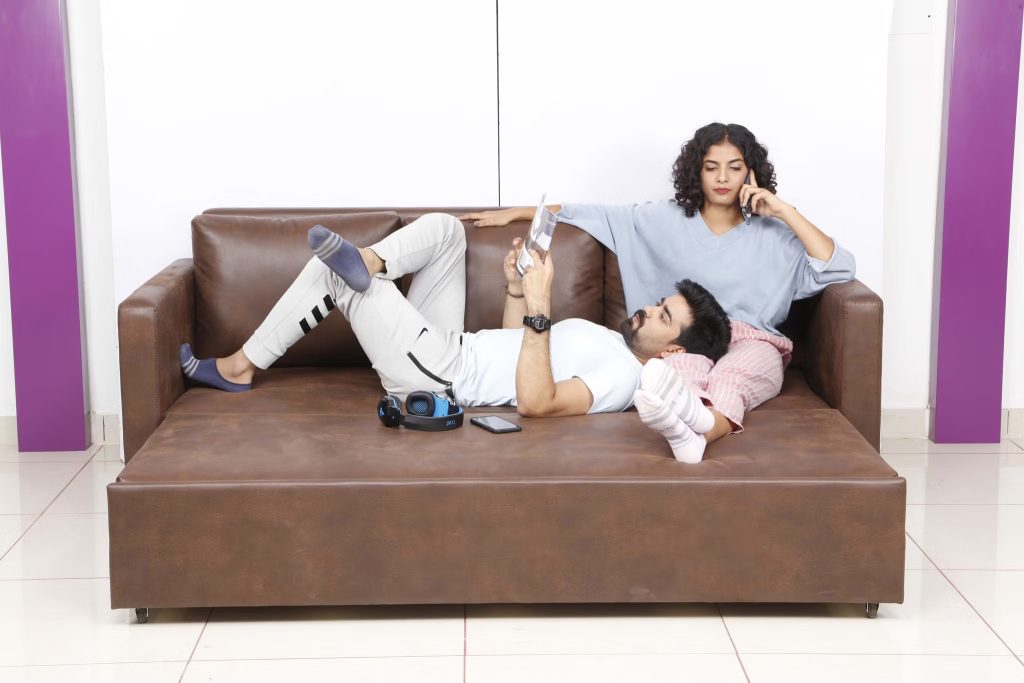How Technology Impacts Sleep: Tips to Reduce Screen Time Before Bed
In today’s digital age, technology is a central part of our lives, including our bedtime routines. While gadgets like smartphones, tablets, and computers offer convenience and entertainment, they can also negatively impact our sleep. The blue light emitted by screens, along with the stimulating content, can interfere with our ability to fall and stay asleep. In this blog, brought to you by Restolex Mattress Company, we’ll explore how technology affects sleep and provide practical tips to reduce screen time before bed to improve your sleep quality.

How Technology Affects Sleep
- Blue Light Disruption:
- Impact: Blue light from screens suppresses the production of melatonin, the hormone responsible for regulating sleep. Reduced melatonin levels make it harder to fall asleep and can disrupt your sleep-wake cycle.
- Solution: By reducing blue light exposure before bedtime, you can help your body produce melatonin naturally and prepare for restful sleep.
- Mental Stimulation:
- Impact: Engaging with stimulating content such as social media, news, or video games can keep your mind active and make it difficult to unwind. This mental stimulation can delay the onset of sleep and reduce overall sleep quality.
- Solution: Limiting exposure to stimulating content in the hour or two before bed helps your mind relax and signals that it’s time to wind down.
- Disruption of Sleep Routine:
- Impact: The use of technology, especially late at night, can disrupt your sleep schedule. Late-night screen time can lead to irregular sleep patterns, making it challenging to maintain a consistent sleep routine.
- Solution: Establishing a technology-free bedtime routine helps reinforce a consistent sleep schedule and improves your overall sleep quality.
Tips to Reduce Screen Time Before Bed
- Set a Technology Curfew:
- Tip: Establish a specific time each evening to stop using electronic devices—ideally one to two hours before bedtime. Use this time to engage in relaxing activities that help you wind down, such as reading a book or practicing mindfulness.
- Example: If you plan to go to bed at 10 PM, set a technology curfew of 8:30 PM to start winding down for the night.
- Create a Relaxing Bedtime Routine:
- Tip: Develop a calming pre-sleep routine that doesn’t involve screens. This could include activities like taking a warm bath, doing gentle stretches, or practicing relaxation techniques such as deep breathing or meditation.
- Example: Spend 30 minutes before bed reading a physical book or journaling to relax your mind and prepare for sleep.
- Use Blue Light Filters:
- Tip: If you need to use electronic devices in the evening, consider using blue light filters or apps that reduce blue light emission. Many devices now have built-in settings that can adjust screen colors to warmer tones during evening hours.
- Example: Activate the “Night Shift” mode on your iPhone or “Night Light” mode on your Android device to reduce blue light exposure.
- Limit Content That Stimulates:
- Tip: Avoid engaging with content that can be overly stimulating or stressful, such as news, social media, or work-related emails, in the hour leading up to bedtime. Instead, opt for calming or neutral content.
- Example: Switch to listening to soothing music or an audiobook rather than browsing social media or watching action-packed videos.
- Create a Tech-Free Zone:
- Tip: Designate your bedroom as a technology-free zone. Keep electronic devices out of the bedroom to create a peaceful and restful environment conducive to sleep.
- Example: Place your phone and tablet in another room or on a charging station outside your bedroom before you go to bed.
- Use Sleep-Friendly Lighting:
- Tip: Install dimmable lights or use lamps with soft, warm light in your evening environment. Avoid bright, overhead lights that can disrupt your body’s natural sleep signals.
- Example: Use a bedside lamp with a warm, low-intensity bulb to create a relaxing atmosphere before bedtime.
- Practice Digital Detox:
- Tip: Incorporate regular digital detox periods into your routine. Allocate specific times during the day or week to unplug from screens and engage in offline activities that promote relaxation and well-being.
- Example: Designate one hour each evening or one day a week to be screen-free, focusing on activities like hobbies, spending time with family, or enjoying nature.
- Invest in a Comfortable Sleep Environment:
- Tip: Ensure your sleep environment supports restful sleep by investing in a high-quality mattress that provides optimal comfort and support. A good mattress can enhance your overall sleep quality, making it easier to fall asleep and stay asleep.
- Example: Explore Restolex’s range of mattresses designed for exceptional comfort .
Conclusion
Technology, while offering many benefits, can interfere with our sleep if not managed properly. By reducing screen time before bed and adopting healthy bedtime habits, you can improve your sleep quality and overall well-being. Set a technology curfew, create a relaxing bedtime routine, and invest in a sleep-friendly environment to support restful nights.
Newsletter Sign Up
Join our community to receive exclusive updates, sleep tips, and special offers directly in your inbox. Stay informed and be the first to know about our latest products and promotions.

Contact Us
- 9/1, Ashokapuram, Industrial Suburb, Yeshwanthpur, Bengaluru-560022, India
-
care@restolex.com
Orders@restolex.com
Support@restolex.com -
+91-8750054466
+91-8123018558
